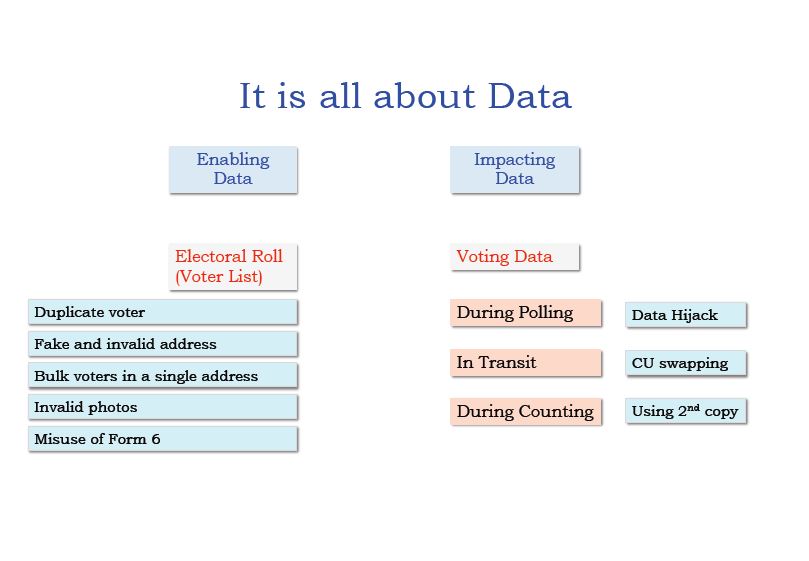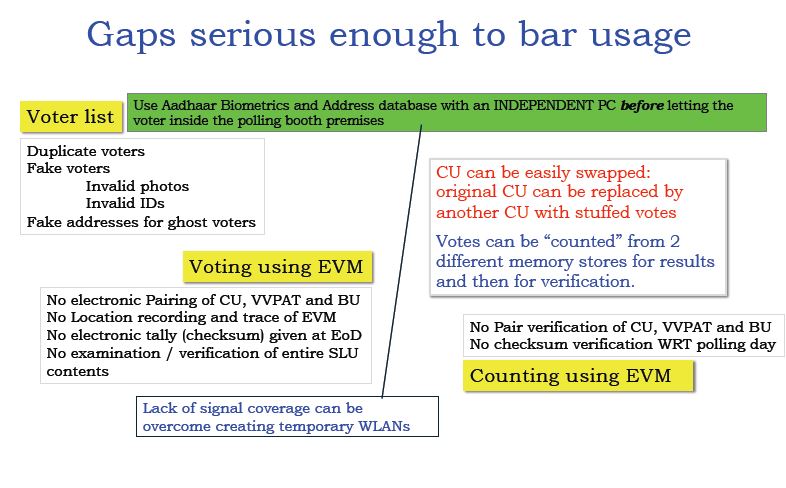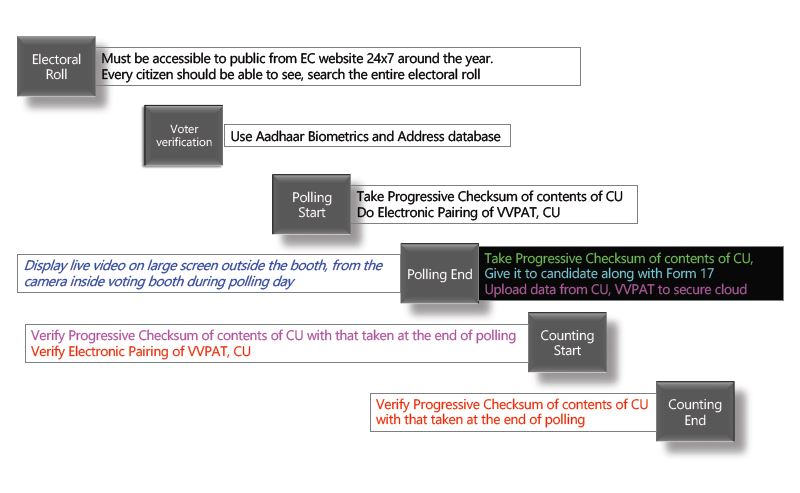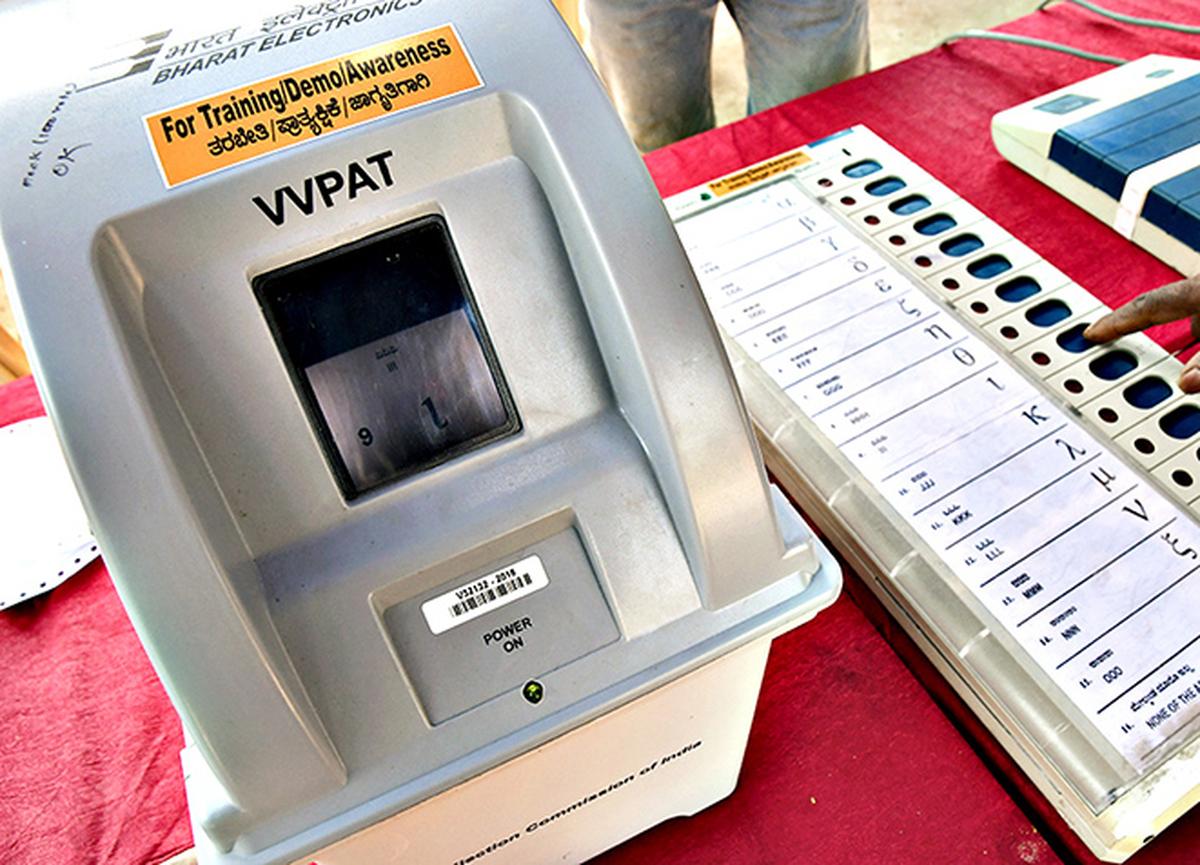Madhav Deshpande, with four decades of experience in computer science and a former Consultant with the Obama administration, in a special intervention with Vote for Democracy (VFD) has warned citizens not to brush aside the issue of EVM manipulation (what he terms as ‘vote hijack’). Explaining this phenomenon in detail at a recently held interaction with citizens activists in Bengaluru on August 16, Deshpande said that all the 3 parts of the process remain compromised and questionable: The electoral roll (voter list), the EVM on polling day and the EVM on counting day. These are not mutually exclusive; they work together, amplifying the effect of dacoity (=theft + hijack).
A strong votary of preservation of data integrity and security, Madhav Deshpande has explained here how the entire electronic election cycle is ‘compromised by compromised data.’ He also urged the voters and citizens must not forget the obfuscation introduced by the “percentage” voting instead of vote counts.
Diagram 1: Explaining Data

In the detailed and creative presentation, Deshpande explained that applying a “manual lock, key, to seal an electronic process” is ineffective as is the misplaced discourse on ‘whether or not the machine can ever go wrong or about “proving” if the “machine” is infallible.’ The focus of electors, citizens groups and the media –as also all political parties who are stake holders – should be about proving data integrity. Now, proving integrity means proving that data has remained unchanged across its entire path. In our voting process, the Voting Data Path is across the Ballot Unit (BU), Counting Unit (CU), the VVPAT and back at the CU. For complete Data Integrity, says Deshpande, it must be electronically proved that the data in BU (button presses) is identical to data in CU (both copies), as data in VVPAT. Therefore, since the protection of secrecy of the Vote is paramount, each successive data element (vote) must not be disclosed. Hence, a progressive checksum or hashsum (like CRC or MD5 or MD6) must be taken in every BU, CU and VVPAT, printed and handed over to candidates at the end of the day, polling day. FORM 17 was for paper ballot, it serves little purpose now. Now, a Checksum/ Hashsum is needed for electronic ballot. Hence, the Checksum must be again generated before counting and tallied with the EoD checksum to prove that the data is unchanged from the end of polling.
Diagram 2: Data Integrity

No paring of electronic devices –How else do we understand that the existing EVS (electronic voting system) is compromised? How do we understand also that the Data Integrity is compromised, which in turn means that every Voter’s Vote, the Secrecy and Integrity of every Ballot is compromised?
Above Deshpande has explained how their must be an electronic safety lock, the Checksum/hashsum at every stage of the Voting Process, evidence of which must be given to every candidate at close of Voting, Start of Counting.
Now, he explains how more needs to happen. Diagram 3 (below) explains how to combat the corrosive phenomenon of fake voters, duplicate voters and ghost voters with fake addresses the system needs to use an Aadhaar kind of Biometrics and Address database with an INDEPENDENT PC before letting the voter inside the polling booth premises. Second, the VVPAT unit, CU (Counting Unit) and Ballot Unit (BU) need to be ‘paired’. If the earlier recommended procedure of ‘electronic locking’ (checksum/hashsum) is applied and thereafter, the units are ‘paired’ the system becomes foolproof. Without this happening, between Voting Day and Counting Day, the CU can be easily swapped: original CU can be replaced by another CU with stuffed votes. Worse, Votes can be “counted” from 2 different memory stores for results and then for verification.
Diagram 3:


Uniqueness is intrinsic to Freedom
In the words of expert Madhav Deshpande himself, “Among the many things that freedom entails, equality and uniqueness are two crucial and important aspects.
When one has a duplicate, one’s uniqueness is lost. Say there is a duplicate voter ID card for me. And let us say there are only 2 parties in India. I vote for BJP, while the other votes for Congress. Now, my vote makes no impact, as both parties get 1 vote in my name. In other words, my democratic value is reduced to 0. I am totally marginalized. In other words, I don’t matter anymore. This is not just scary, it is demeaning to each one of us.
Madhav Deshpande appeals, “Each one of us who values freedom must speak up against this marginalization. This is not about any political party.
If you value freedom, you will be up in arms against this.
Related:
Major Irregularities in 2024 Maharashtra Vidhan Sabha Polls; Vote for Democracy
99.8% of 65 lakh voter deletions go unchallenged on 13th day of objection period
